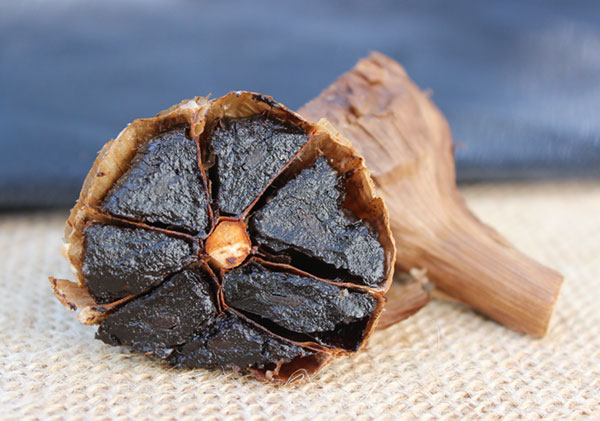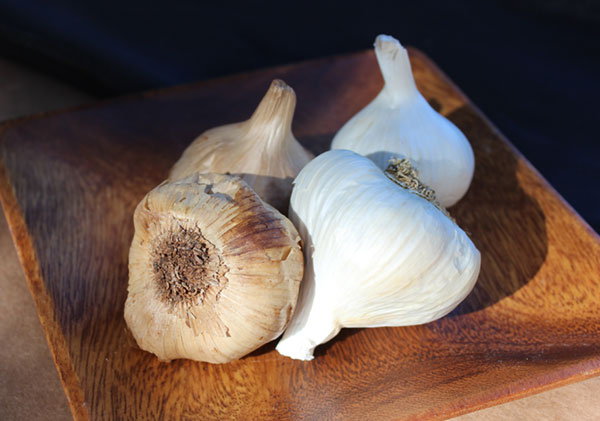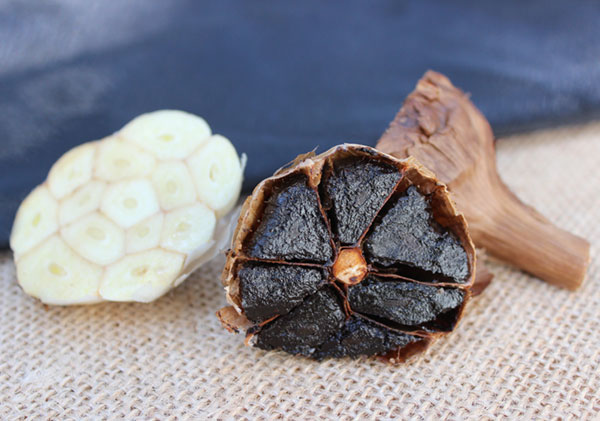Black garlic
What is Black Garlic, Is It Better Than Raw Garlic

Black garlic has a long history of use as a prized medicinal and culinary superfood in several Asian countries, primarily Korea, Japan and Thailand. It is often claimed to have originated in Korea where the aging process was thought to have been developed and perfected over many centuries.
Utilized today for its distinct flavor and texture as a gourmet ingredient, it is also becoming popular for its exceptional nutritional value that in some aspects supersedes the raw garlic it was created from.
Made from whole unpeeled Allium sativum bulbs, it is allowed to age for a period of time, eventually darkening the bulbs and turning the cloves a dark black licorice-like color.
Commercial aging or “fermentation” can range between 60-90 days or longer, depending on the designated temperature. This is achieved in a humidity-controlled setting using a specialized fermentation device in which ideal temperatures can range between 140-170°F (60–77°C).
When the moisture content is reduced to a certain level, the cloves blacken considerably and develop a unique soft sticky date-type consistency.
One of the most prominent features of black garlic is its taste, often described to have a slightly tangy yet subtly sweet flavor. To us it has a very unique but delicious taste, resembling a cross between shiitake, figs and balsamic vinegar.
The increase in sweetness is a result of fermentation in which the carbohydrates in raw garlic are broken down into simple sugars and the protein into amino acids. This essentially removes the spiciness and pungent flavor found in fresh cloves.

Is Black Garlic a Fermented Food?
While black garlic is often referred to as “fermented” it doesn’t actually involve specific microbial processes like other fermented foods.
Basically, the enzymes in raw garlic break down and encourage the Maillard reaction, a chemical occurrence between amino acids and reducing sugars known to “brown” food. This process is very similar to caramelization or the browning of sugar. It is therefore more accurate to say that it is “aged” rather than fermented.
However, according to some 2018 research, there has been some bacterial endophytes, like Bacillus, observed in black garlic production that have an affinity for high temperatures as well as the capacity to encourage fermentation. These are beneficial bacteria that are naturally present in fresh garlic and believed to play a role in aged garlic transformation, but are largely diminished at the end of BG aging.
So, while there is some truth to its reference as a “fermented food”, it is not found to contain high amounts of enzymes or probiotic benefits like other ferments, mostly because of the high heat exposure.

Black Garlic Versus Raw Garlic
Black Aged Garlic, Higher in Antioxidants Like SAC
So, what are the differences between black aged garlic vs. raw garlic? While fresh raw garlic or sprouted garlic is definitely a potent medicinal superfood, antibiotic and antiviral agent to include in the diet from time to time, when aged it essentially becomes much higher in antioxidant content.
The unstable compounds prominent in fresh garlic, such as alliin and allinase (which make allicin when garlic is crushed), essentially get converted after the aging process to potent substances that possess strong antioxidant activities. One of the major ones is a constituent known as S-allyl-cysteine or SAC. (*)
SAC, a water-soluble sulfurous compound and derivative of the amino acid cysteine, is amplified when subject to heat and the breakdown of protein. S-allyl-cysteine, compared to fresh garlic’s health-enhancing component “allicin”, is considered to be more stable and easily absorbed in the GI tract. It has been shown to encourage other enzymatic antioxidant activity as well as provide benefits as a powerful free radical scavenger and neuroprotective anti-inflammatory agent.
Along with S-allyl-cysteine, aged garlic also produces other antioxidants like S-allylmercaptocysteine, polyphenols, flavonoids and other lipid and water soluble organosulfur compounds. The process of garlic fermentation also likewise increases some of the “antioxidant nutrients”, such as zinc and selenium.
Because blackened aged garlic is much lower in moisture content its amino acids and other nutritional properties are considerably more concentrated. It is, in fact, identified in some research to have over 4 times as much polyphenol and flavonoid content.
Black Garlic Vs. Raw Garlic
Black Aged Garlic
- Higher in Antioxidants
- More Fiber and Protein
- Easier to Digest
- No Garlic Breath
- Sweet and Tangy
- Higher in Some Minerals
- Mild Immune Boosting Effect
Fresh Raw Garlic
- Higher Vitamin C
- Less Acidic
- Contains Allicin
- Potent Antiviral
- Natural Antibiotic
- Spicy Pungent Flavor
- Strong Immune Booster
Other Benefits of Black Aged Garlic
Fermenting garlic produces a sweet, tangy, mild umami-like flavor and removes the spicy pungent qualities, making it easier to digest for some people. It is often better tolerated by those with heat sensitivities or a Pitta body type. Because of the diminished allicin content, it also doesn’t give you “garlic breath” like the fresh variety.
After raw garlic is aged, it is higher in fiber, protein and certain minerals are also known to be increased, such as zinc, potassium, magnesium, iron, manganese, phosphorous and selenium.
Some scientific observation shows that black aged garlic has a more acidic pH than fresh garlic, which is 1-2 points more alkaline. According to one study, “the pH of BG [Blk Garlic} significantly decreased from 5.27 to 4.01 during thermal processing, compared with 6.29 for FG [Fresh Garlic}.”
Research on Black Garlic, Potential Health Enhancing Properties
In recent years there has been quite a bit of research demonstrating the protective benefits of black garlic consumption for a number of health conditions.
Black fermented garlic has been scientifically acknowledged as beneficial for:
- Type 2 Diabetes Mellitus (*)
- Cholesterol Metabolism and Cardiovascular Health (*) (*)
- Neurogenerative Conditions and Cognitive Functions (*) (*)
Make Your Own DIY Black Garlic
The price of black aged garlic bulbs, cloves or supplements can be quite high compared to fresh garlic because of the required fermentation process. However, if you’re serious about using it on a regular basis, it can be made DIY style using a rice cooker or a purchased black garlic fermenter.
The latter is a modern specialized appliance that keeps the garlic at a uniform temperature using a humidity controlled system. You simply place in your whole raw bulbs and push a button. From our research, most brands will ferment or age the garlic in about 8-12 days at a temperature of 100-170°F.
Black aged garlic has a much longer shelf life than raw garlic, but is usually best when preserved in a cool place or refrigerated.
Precautions:
Black garlic when consumed in large quantities may cause gastrointestinal upset and should be avoided if you have allergies to garlic or members of the onion family. Seek the advice of your healthcare provider if you are pregnant, nursing, taking prescribed medications or have a serious medical illness.

 no
no no
no no
no
Leave a Reply
Want to join the discussion?Feel free to contribute!